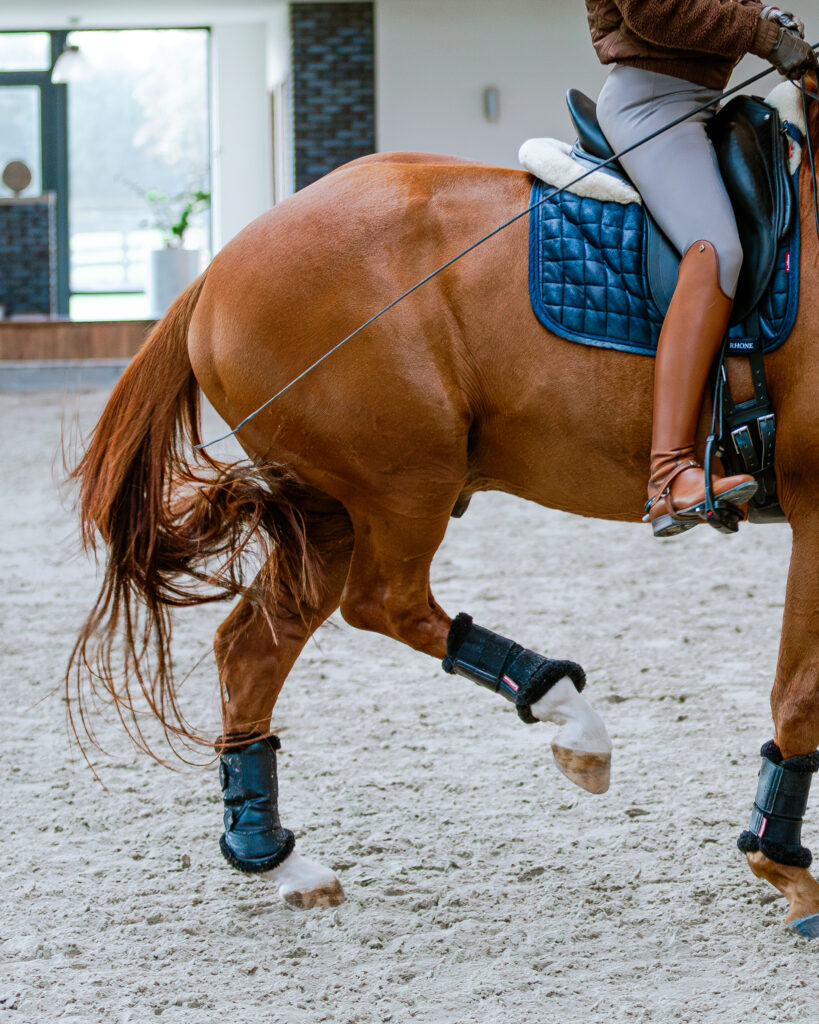
The Misconception About Relaxation and Performance in Equestrian Sports
Many trainers and athletes in equestrian sports believe that relaxation leads to reduced engagement and movement. They perceive that if a horse starts to relax while jumping, it will jump lower or stop jumping altogether. Similarly, the common belief is that a cantering horse, when relaxed, may slow down to a trot, a trotting horse may drop to a walk, and a walking horse may stop and stand still if it begins to relax.
This perception often relegates relaxation to merely a nice addition in horse training, not the guiding principle, especially when it comes to the sportive, athletic performance in equestrian sports.
This misunderstanding stems from the belief that relaxation equates to the cessation of movement, associated only with rest.
The Paradox of Avoiding Relaxation Despite Its Necessity
Interestingly, many trainers, horse owners, and breeders I’ve spoken with say their horses lack relaxation or need more of the qualities that directly stem from the state of being relaxed. Top sport horses are too nervous, too easily spooked due to being tense (and lacking relaxation), or perform poorly due to incorrect body usage that is the direct outcome of tension (which is a lack of relaxation). Dressage horses, for instance, may be tense and stiff, hindering their ability to execute dressage exercises with sufficient suppleness and flow of energy through the body, and jumping horses lack scope and good bascule over the jump due to tension and contraction over the topline.
It’s paradoxical that trainers avoid relaxation in training due to the fear of movement loss, yet complain about horses’ lack of relaxation on so many fronts, like movement, behavioral problems, anxiety in paddock and during shows, anticipation, and lack of focus. Some top dressage trainers even believe a horse must be excited or nervous to be expressive. This belief contributes to the problems of horses being easily spooked, stiff, and less effective in their movement as they age.

If we look at the top sport horses, they are hardly ever side-tracked from the top sport because they were “too relaxed”; most of them are getting side-tracked because they have sustained injuries, are too fearful or anxious, they are too stiff, don’t use or can’t use their bodies properly due to stiffness, contraction, and tension, don’t show a good picture (tail swishing, teeth grinding), or because they anticipate what will happen next and are not enough together with the rider in order to learn effectively and in the right timeframe what is expected of them. All these aspects come from the fact that the horse is too tense, not too relaxed. Why then are trainers and riders worldwide so scared of Relaxation? Because they have not seen a consciously relaxed horse performing so far. But this is changing.
Many horses and humans alike experience moments of Relaxation during the day, usually these are moments of rest when we consciously disengage from our activities. We sit down, relax, rest, watch TV, or meditate. For our horses, it’s their paddock time, box rest. This is relaxation experienced at the amateur level where Relaxation = Stopping an activity.
Conscious Relaxation: The Key to Unlocking True Performance
In athletic training, we need to take this kind of Relaxation to the next level; we need Performance Relaxation, and we need to make it conscious. Conscious Relaxation means that the horse learns what is the essence of Relaxation. In the Optimal Performance Program, we describe relaxation as the state when the action ceases. When the horse learns this basic principle at the halt, then we move to teaching him this while in motion — because when in movement, the horse can also cease activities. What are the activities the horse will be ceasing? Is it the jump that will get smaller, or will cease altogether? Is it the canter that will drop and turn into a trot? No. The horse will be learning to consciously disengage all tensions that he is sustaining within the given spectrum of movement that are not directly connected and required by this movement, in order to free the energy that had been frozen for sustaining these unnecessary tensions and direct it into the bettering of the required movement. Sounds like Sci-Fi? Not exactly.
The Science Behind Conscious Relaxation in Athletic Horses
Conscious Relaxation within the spectrum of movement is entirely possible and used in competitive sports by leading human athletes. They learn this relaxation consciously through biofeedback. Over 15 years ago, I discovered techniques of teaching this experience to horses and I developed them into the Optimal Performance Program, helping horses understand this state and how to transfer it into movement and engagement. The horse learns to consciously scan its body for tensions and release them, whether standing still or in motion.

As a result, these horses not only move beautifully with energy flowing through their bodies, but they also become calm and connected with the trainer. They start to use correct movement patterns as they relax additional tensions created by unnecessary effort, too early and too demanding introduction to the new exercises, training beyond their capabilities, or introducing new elements and jump heights regardless of the horse’s physical or mental readiness. The Optimal Performance Program helps to resolve the horse’s general tendency to gather tension and lack of skills to handle these additional requirements other than by introducing more tension into the body. With the Optimal Performance Program, the horse can learn how, while staying in the spectrum of movement, to scan his body consciously looking for unnecessary tensions and release them in order to restore correct movement patterns, ease any emotional and mental tension, free muscles needed for better engagement, greater strength and more stamina, and most importantly — feel good himself about performing and doing the things that we ask him to do.
Relaxed horses display heightened body awareness, improved jumping and movement capabilities, and better work through their back. Conscious Relaxation acts like the best tonic — thin horses gain muscle tone and become nicely round, horses who have problems with becoming too heavy come back to their optimal weight and condition. Horses, in general, develop more aesthetically and functionally pleasing muscles, that are soft, and not hard, under the touch, and become calmer, more attentive, and responsive to the trainer, and enhance their body awareness. This is vital in competitive sports where reactions often occur in split seconds. For instance, a jump only lasts a fraction of a second, making it challenging to adjust or consciously influence the movement during its execution. In order to improve such performance, we need to rely on other training modalities than repetition; we need to prepare the horse better for the execution of such performance.
Transforming Performance into Therapy: A New Approach to Training
As much as the principles I am speaking about are in the same way true for dressage training, as they are for jumping training, it is perhaps easier to explain them and understand the concept in the jumping training context. Imagine a jumping horse, who can only give a certain number of jumps weekly. The trainer has a limited possibility of introducing improvement to the jumps, by affecting them directly as the jump lasts only for a fraction of a second, as we already said before. Therefore, the trainer needs something “more”, that would ideally also not tire the horse. Our proposition is Relaxation within the jump: with the Optimal Performance Program, the horse himself can learn how to scan his body as he jumps (we get there in a progression of steps, starting from being able to consciously relax at the halt, later when walking over a cavaletti, to jumping over a cavaletti later on), and therefore we can leave all the responsibility for freeing the muscles and restoring correct movement patterns on the horse. Who knows his body better than the horse himself? We just need to treat him as a partner, and give him tools to execute what we expect.
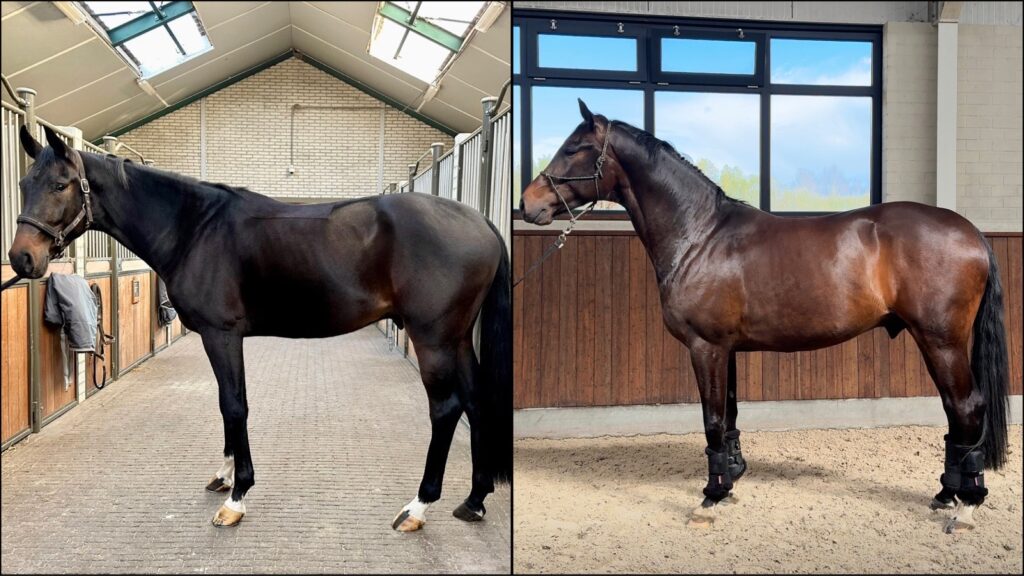
Conscious Relaxation in the Spectrum of Movement – Optimal Performance Program – means that as the horse relaxes, it doesn’t stop engaging. Rather, the horse monitors its body and detects unnecessary tensions associated with the movement or phase of a specific movement. These unnecessary tensions can be deactivated, disconnecting them and redirecting the released energy to intentional action, such as jumping, lifting a leg, lowering the pelvis, or shifting more weight on the hind legs.
A consciously relaxing horse in motion has more energy because more muscles are released, freeing those that aren’t required. This releases tensions, and the energy from these released tensions can be redirected to intentional actions expected from the horse. Consequently, the horse’s movement patterns and performance enhance, their health improves as they don’t work against their tensions, resulting in a ‘happy athlete’. We end up with a horse that feels good, moves excellently, has heightened body awareness, and improves its own movement. All these enhancements occur because the horse has consciously learned to relax its body under various conditions.
This brings us to our Optimal Performance Program. It’s specifically designed to teach horses relaxation within the movement spectrum. The program consists of eight relaxation techniques. The horses learn to implement these techniques into their movements. These techniques include relaxation for movement pattern changes, such as during transitions or introducing a new movement pattern like a jump, transitioning from a trot to a gallop, piaffe, passage, moving with collected or extended gaits.
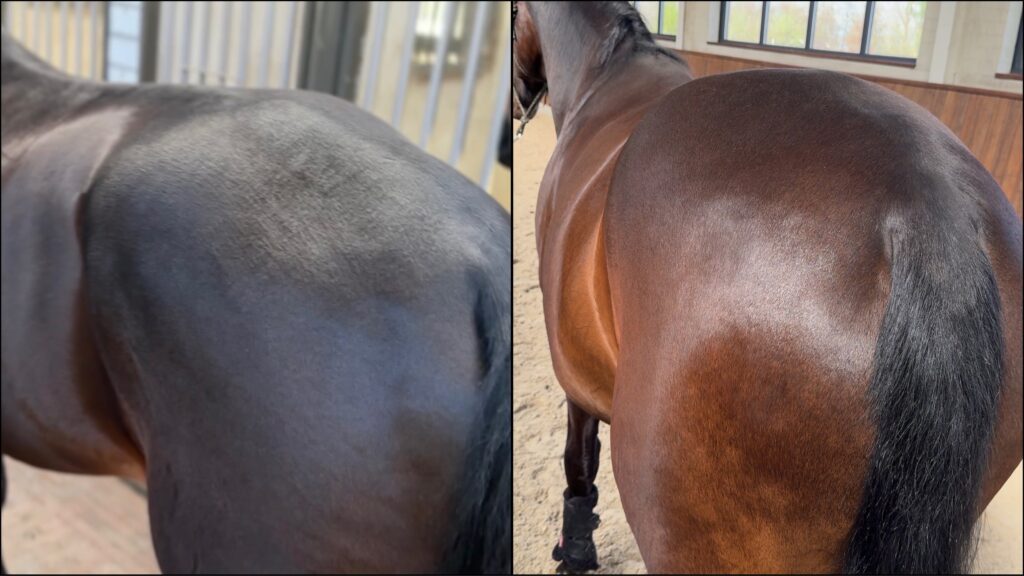
We also have relaxation for Elevated Heart Rate, crucial for sport horses. The horse learns to consciously relax even when its heart rate increases with exertion. Anyone who practices sports knows that maintaining good body awareness is challenging when your heart rate is high. The same applies to horses, making this an essential relaxation technique for sport horses.
In the Performance Program, we have eight such targeted and effective relaxation techniques for sport horses, ensuring we can cultivate a fully responsive athlete. We don’t necessarily need to alter our training, but we can equip the horse with these techniques so that our training doesn’t create tension. The horse responds to our training by relaxing and better understanding our expectations, physically performing better with a more positive mental attitude.
If your horse stiffens during training, shows a decline in movement quality, or struggles with obstacle work at Grand Prix level, this program is designed for you. Whether your horse is stiff, skittish, resists training, learns slowly, or lacks body awareness, and teaching it flying changes or piaffe transitions is time-consuming, our program can help.
This program is also ideal for horses in rehabilitation from various injuries, or for those who wish to prevent such injuries. Many injuries result from excessive tension in the horse’s body, creating opposing forces where one muscle group pulls the leg in one direction and another in a different direction. The horse ends up moving in conflict between these forces, resulting in incorrect movement or compensation.
So, if you want to improve your horse’s movement, speed up its recovery, enhance its health and mood during training, and create a true athlete with full access to its body, you need to incorporate relaxation in its range of movement. As an owner or trainer, don’t fear relaxation. In human sports, relaxation is incredibly popular. All top athletes use biofeedback and learn to relax and reduce effort in their movement to make it as efficient and optimal as possible.
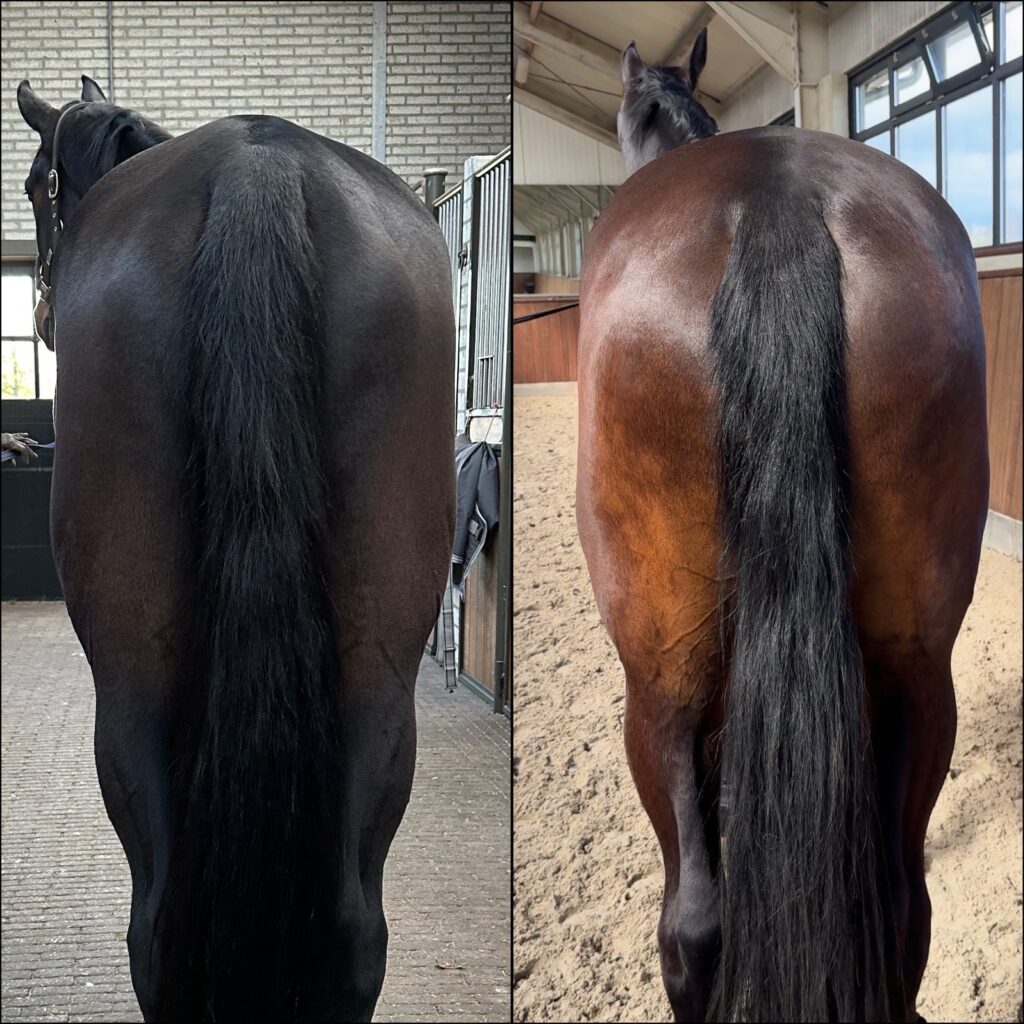
The Optimal Performance Program: Elevating Sport Horses to New Heights
This brings us to our Optimal Performance Program. It’s a course of action that provides an optimal performance tunnel for your horse. Optimal means the best possible for your horse’s health, ensuring movements aren’t made at the expense of compensation and future health problems. Training a horse to Grand Prix level takes years of work, so it’s crucial that we train horses in a way that allows them to use their skills for years to come when they reach ages 9, 12, or 14, rather than ending their careers due to tension-related problems like ulcers, breathing issues, nervousness and tension related injuries, muscle atrophy and inflammation of the joints and arthritis.
Instead, we want them to enter this golden stage of their lives where they can utilize all the knowledge and time invested in their training over the coming years. Just as in human sports, where athletes can remain at the top of their game for longer periods, this extension is due to relaxation. It’s not shameful for top performance athletes to have mental coaches, sports psychologists, and physiotherapists focused on releasing tension caused by performance. Top human athletes meditate, engage in biofeedback, and learn how to perform without any effort, which is the essence of Relaxation in the Spectrum of Movement.
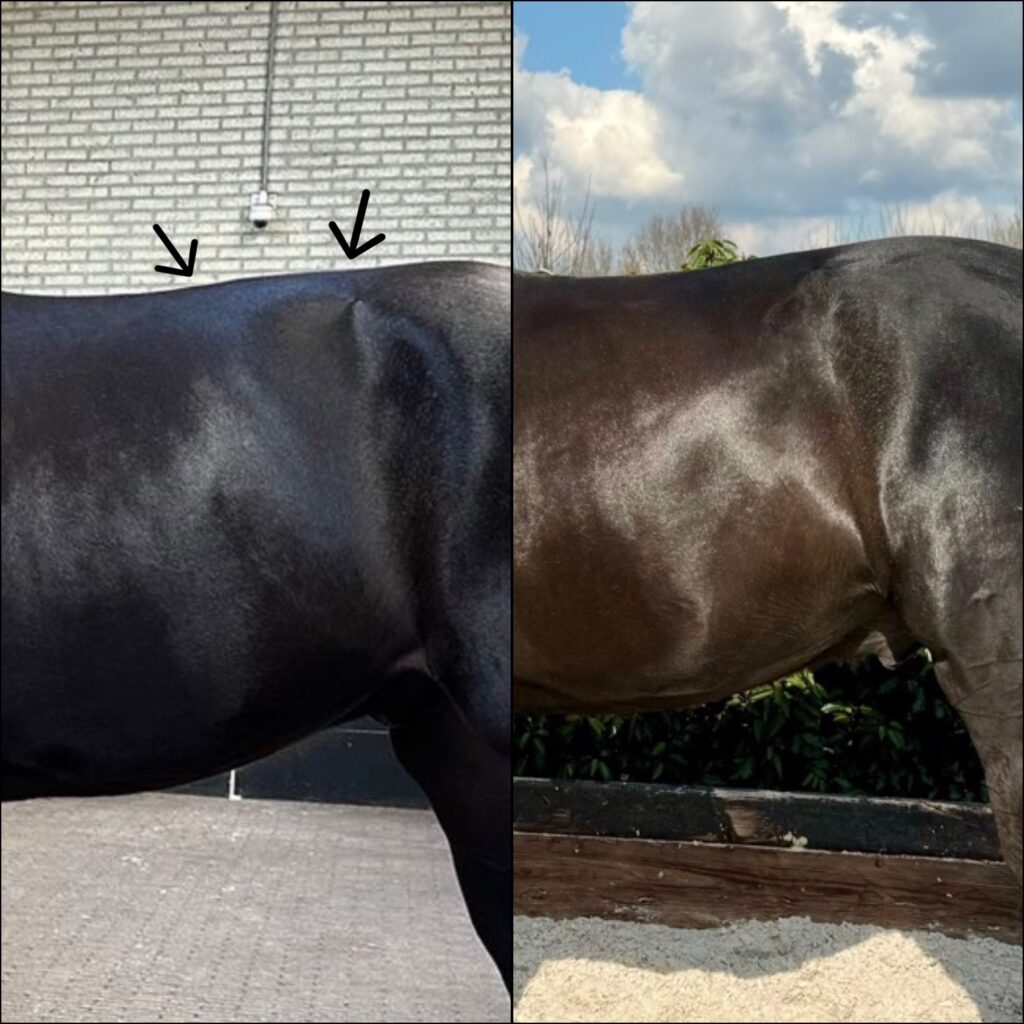
The Happy & Relaxed Athlete: A Vision for the 21st Century Horse
At OneHorseLife.com, we aim to bring these qualities to the top sport for equine athletes. Horses, too, can learn how to consciously relax within their performance. I see that horse owners and trainers are more than ready to take this step to support their equine partners — I observe this in the growing popularity of physiotherapy and devices like magnetic rugs and devices using PEMF. These are all techniques to reduce stress and tension, thereby increasing the relaxation of the muscles of the performance horses. Where do horses accumulate this tension? During performance! So, why not take the next step and transform PERFORMANCE INTO THERAPY. Your horse can truly become healthier, move better, and be happier and more relaxed mentally and emotionally as he engages in athletic performance with you. Your horses should be able to bring you joy, success, and satisfaction, while also becoming healthier, happier, and achieving greater success themselves.
Our ultimate goal is to redefine what it means to be a true “Happy Athlete” in the 21st century. When I envision the modern equine athlete, I see a consciously relaxed horse — one that not only excels physically but is also emotionally and intellectually pleased, balanced and engaged. It’s a horse that performs at its highest potential, but more importantly, does so with a sense of inner balance and well-being, because by doing so he is coming more in alignment with his own needs. Our training isn’t just about enhancing physical performance; it’s about nurturing the horses’ mental and emotional state, allowing them to thrive holistically in every aspect of their training and partnership with their riders. This is the future of equine sports — a horse that is as connected to its body as it is to its mind, and heart: fully present, and ready to meet any challenge with confidence and ease.

If you want to take this step, let me help you and share with you my over 15-years experience in the field. My clients are GP jumping riders, 5* eventing riders and top dressage riders from the competitive field. I cannot wait to help you and your horse find ease and relaxation in the spectrum of movement. Book your Consultation Call with Anna and let’s discuss the best training plan for you and your horse.
Text: Anna Marciniak, OneHorseLife Anna@OneHorseLife.com
Photos and Video production: Julia Slomkowska JulaSloma@gmail.com
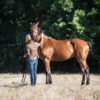


Its like you read my mind You appear to know so much about this like you wrote the book in it or something I think that you can do with a few pics to drive the message home a little bit but other than that this is fantastic blog A great read Ill certainly be back